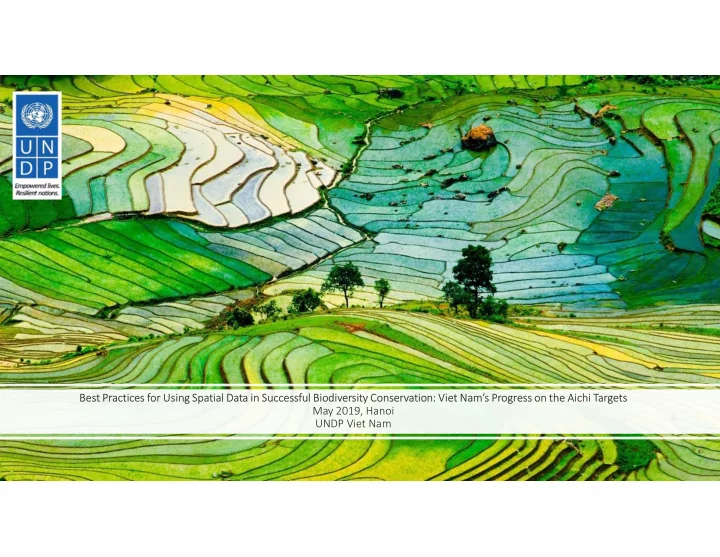

Best Practices for Using Spatial Data in Successful Biodiversity Conservation: Viet Nam’s Progress on the Aichi Targets May 2019, Hanoi UNDP Viet Nam
Background Viet Nam is a party to CBD in 1994. Viet Nam is ranked 16 th among the Earth’s most biodiverse countries and is one of the ten richest centers of biodiversity in the world. In the last 20 years, Viet Nam’s population has increased from less than 73 million in 1995, to over 96 million in 2017, in turn creating a large demand for resource consumption and land use to meet the needs of increasing urbanization and infrastructure, which has created a pattern of unsustainable consumption.
Data trends have shown that each of Viet Nam’s unique ecosystems – forests, coral reefs, seagrass and mangroves – are under continued threat due to overexploitation, unreasonable use and environmental pollution. Recognizing the importance of biodiversity, the Government of Viet Nam (GOV) has made great efforts towards its strengthening, protection and conservation. To date, some achievements towards biodiversity conservation have been recorded, but many barriers remain to achieving notable and sustainable progress.
terrestrial PA National Target 9% terrestrial area The overall target of Viet Nam’s National Biodiversity Strategy and Terrestrial PA: 9% Action Plan to 2020 is that naturally important ecosystems, endangered, rare, and precious species, and genetic Marin PA: 9% Marine PA 0.24% resources are preserved and used sea area sustainably, contribute to the development of the green economy, and actively respond to climate 45% forest cover change.
Spatial Data in Practice In Viet Nam, spatial data has been used to investigate, review and map ecological regions, helping to identify areas of high biodiversity value, areas that have been degraded, and those that may be more sensitive. With this, the country is better able to conduct research, collect statistical data to assess the situation, and develop a data bank and maps of those areas rich in biodiversity. Viet Nam’s NBSAP utilizes spatial data and GIS to track the progress of the overall and specific targets, as well as to implement further policy and active measures to preserve and recover biodiversity. From this, the bulk of Viet Nam’s progress on the Aichi targets have occurred in Strategic Goals B, C and D.
Forests in Viet Nam are habitat to most Terrestrial - terrestrial wildlife species and have some of the highest biodiversity rates in the country. Forests Viet Nam has had strong reforestation and forest protection policies in place since the 1990’s, which has produced a significant data is available regarding the progress of this target. Forest cover rate between 2010-2017
As shown by these maps, it is apparent that forests in Viet Nam face threats from human activities, such as increased urbanization or agricultural expansion Forest cover increases but forest quality is declining. Biodiversity Intactness Human Footprint (2009)
Protected Areas The data gathered from these maps allows the government and its various agencies to identify problem areas, and then can use this to inform policy and other decision-making regarding biodiversity.
Human Pressure on Protected Areas Spatial data is used to demonstrate human pressure to protected areas, allowing researcher to make recommendations of where policy interventions should take place.
Currently, there are 164 protected areas. The goal is to have 176 protected areas by 2020
Mangroves Spatial data has also been instrumental in mapping and recording Viet Nam’s coastal ecosystems. Despite the relative success with terrestrial forest restoration, the same cannot be said regarding coastal forests, specifically, mangrove coverage. Mangrove distribution 2014 Mangrove coverage has shown a significant downward trend, with 4/5s mangrove areas having been lost over the last 60 years. However, while 2015 marked the lowest mangrove cover, with only 57,211 ha, by through monitoring and restoration projects, in 2017 this number had more than doubled to 213,142 ha. Mangrove area coverage 2010-2017
Coral Reefs and Seagrass Both coral reefs and seagrass are ecosystems that contain high biomass and support diverse marine fauna. Coral reefs have seen a decline of more than 30% over the last 10 years, and coastal seagrass has lost an average of 40-50% of its traditional area. These ecosystems are threatened by various maritime operations and wastewater discharge, which damage habitats, degrade water quality and increase sediment.
Coral Reefs and Seagrass The data that has been collected regarding the fragility of these marine ecosystems have been incorporated into recent policy decisions, which have been reflected into the expansion of the network of marine protected areas. Marine protected area network
The decision to expand the marine protected area system has depended on the establishment of fishery zoning lines in Viet Nam’s seas have helped to prevent, reduce and eliminate illegal, unreported and unregulated fishing, to promote the development of responsible and sustainable fisheries.
In combination with the spatial data maps of the concentration of juvenile fish, this data has allowed the government to dictate new marine protection areas, while ensuring that marine based economies are able to succeed in a responsible way.
By 2014, Viet Nam has 362 fauna and 219 flora species in IUCN Red Book. 9 species considered extinct in nature in Viet Nam such as two- horn rhinor Dicerorhynus sumatrensis ), Bos sauveli, one-horn rhinor Rhinoceros sondaicus annamiticus Distribution of vegetation and some species in Viet Nam
Conclusions While the data focused on today directly relates to Targets 5, 6, 10 and 11, the developments made in working to achieve these targets also directly and indirectly impact Goals B, C, D.
Conclusions In examining the progress Viet Nam has made towards the Aichi goals, geospatial data is an effective tool, allowing both for scientific use and policy-oriented problem solving. It creates the opportunity for accurate assessment of the targets being pursued at a national level and can be used as a visual demonstration of conservation efforts. They were an important addition to Viet Nam’s NR6 report.
Recommend
More recommend